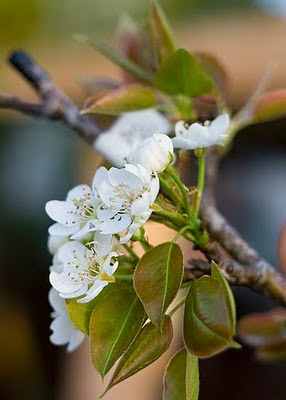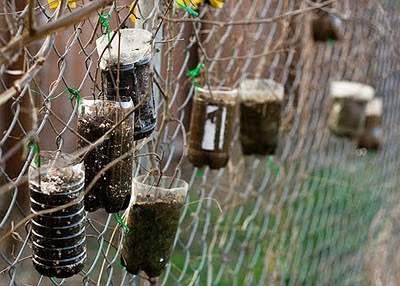...Life is skittles and life is beer.
Okay, enough Tom Lehrer. I've been obsessing over spring gardening since February with my grafting and other such inane chatter, so I figure instead of words it is time to share photographic mayhem of the growth unfolding in my back yard. First up is one of the pear grafts, which is not only still alive, but flowering like there's no tomorrow. This particular graft is what I believe to be a Garber pear:
This other graft is not flowering, but it is leafing out quite nicely. This is the second type of pear graft from early February, and unfortunately I have no clue as to what type of pear this might be. I'm guessing on no evidence at all that it may be a Kieffer, simply because the old tree I took it from is ancient, gnarled and half-dead, so it may be one of those 100-year-old homestead pears you hear about on occasion. This summer I'll be sure to try and examine the fruit to see if I can get a better I.D.
Elsewhere, not quite so dramatic as the grafts but no less significant is the bud break of my Fredonia grape vines. Grape vines always look dead until they burst forth with their rose-and-green leaves in the spring. A few months from now, they'll be sporting bunches of purple-black grapes.
And my passion vines return! All over the yard, the crisp green shoots are emerging from winter dormancy. Incarnata produces lovely, fragrant flowers and delicious fruit. My over-large Texas native is still growing strong, but there are also seedling offspring, crossed with the smaller, more traditional incarnata I have growing elsewhere. These wonderful plants spread aggressively, but in the wild they seem much more subdued and restricted in their range.
Fairy Girl's La Feliciana peach is blossoming as well. It only made one peach last season, although to be fair, that was only its second year in the ground. With the cold winter we had, there's potential for a lot more this year.
These are the muscadines I have growing over the dog run fence a short way down from the Fredonia grapes. Muscadines don't like to root from cuttings, so layering in soil to force root growth is the best way to propagate this type of native grape vine. I've found that 16-20 oz. plastic soda bottles work very well for this. The muscadines don't like my heavy clay soil much, but I add sulphur to bring down the PH and with a little boost of nitrogen they'll produce nice, fat clusters of nutty tasting slip skin grapes.
My fig is leafing out as well, and if you look closely to the left of the stem, you'll see one of the first early crop figs forming already. I've got no idea what type of fig this is--it's an open eye type that spoils quickly once it ripens--but it's mildly sweet and decent enough to eat when fresh. With luck I'll be able to trade for some budwood over the winter and graft some improved varieties onto this one.
That's pretty much it for the back yard, with the exception of some dewberry vines around the side of the house (they took root by accident and don't quite get enough sunlight to produce well). What do you have growing at your place?
Now Playing: John Williams Star Wars Episode I: The Phantom Menace
Chicken Ranch Central








No comments:
Post a Comment